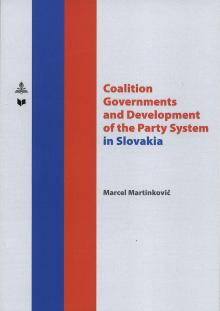Publikácia sa zameriava na charakterizáciu vývoja slovenského straníckeho systému a jeho analýzu z hľadiska formovania štiepnych línií a vznikajúcich vládnych zoskupení. Súčasťou monografie je aj priblíženie jednotlivých typov vznikajúcich vládnych koalícii a ich politologickej analýzy na základe aplikácie indexu RILE (right – left position). Použitie spomínaného indexu má za úlohu špecifikovať programové rozpätie vznikajúcich koaličných vlád a vplyv vývoja straníckeho systému na Slovensku na ich charakter od roku 1990 do roku 2016. Práca sa koncentruje na priblíženie vývojových trendov slovenského straníckeho systému na pozadí programovej homogenity/heterogenity jednotlivých koaličných zoskupení a celkového vývoja variačného napätia straníckeho systému. Zdrojom kategorizácie typov vládnych zoskupení bude vyhodnotenie pozičnej, programovej orientácie strán, ktoré sú zverejnené v rámci medzinárodnej databázy CMP (Comparative Manifestos Project). Databáza Wissenschaftszentrum Berlin für Sozialforschung (WZB) spracováva okrem iného aj dáta týkajúce sa zaradenia jednotlivých programov strán v rámci ich komplexnej ideologickej orientácie. Stredisko sociálneho výskumu v Berlíne tým umožňuje získať relevantné medzinárodne akceptovateľné výsledky komparácie vo vývoji straníckych systémov. Cieľom publikácie bude paralelne charakterizovať aj formát a typ straníckeho systému na Slovensku, jeho konsolidáciu a vznikajúce funkčné problémy medzi volebným a straníckym systémom.
Cieľom publikácie je rozšíriť analýzu slovenského straníckeho systému v kontexte špecifikácie pozičnej hodnoty a programovej orientácie strán na Slovensku základe medzinárodne akceptovanej databázy a kritéria RILE. Publikácia bude obsahovať aj tabuľky s priblížením hodnôt variačného napätia straníckeho systému po každých parlamentných voľbách aj s kvantifikáciou indexu RILE. Na jeho základe následne posúdime programovú homogenitu jednotlivých vládnych koalícií aj vzhľadom na politologický diskurz k danej problematike. Súčasťou práce bude skúmanie hypotézy, či programové približovanie sa strán v rámci ľavo-pravého spektra vytvára priestor pre vznik a etablovanie extrémistických a antisystémových strán v rámci parlamentného zriadenia.
This publication focuses on the characterization of the Slovak party system and its analysis from the perspective of cleavages and emerging government groups. The monograph also includes a description of the individual types of emerging government coalitions and their politological analysis on the basis of the RILE index (right - left positioning). The said index is used to specify the programmatic differences of the emerging coalition governments and the impact of the development of the party system in Slovakia on their nature in the period from 1990 to 2016. The work is focused on the development trends of the Slovak party system on the background of programmatic heterogeneity of the individual coalition groups and the overall development of the variable tensions in the party system. The categorization of the government groups is based on the positional and programmatic orientation of the parties, which was published in the framework of the international database CMP (Comparative Manifestos Project). The Wissenschaftszentrum Berlin für Sozialforschung (WZB) database processes, inter alia, the data relating to the political programs of the parties within the framework of their comprehensive ideological orientation. The Center for Social Research in Berlin thus contains relevant internationally acceptable comparisons of the party systems and their development. The aim of this publication is to characterize the format and type of the party system in Slovakia, its consolidation and the resulting operational problems between the election system and party system.
The aim is also to extend the analysis of the Slovak party system to the specification of positional values and programmatic orientation of the parties in Slovakia based on the internationally accepted database and the RILE criteria. The publication also contains the tables with data on the proximity of variable tensions in the party system after each parliamentary elections and the relevant quantification on the RILE scale. The RILE scale will help us assess the programmatic heterogeneity of the government coalitions also in view of the political discourse on this issue. The work will also verify the hypothesis that the programmatic convergence of the parties in the left-right spectrum creates space for the emergence and establishment of extremist and antisystemic parties in the parliamentary establishment.
Publikácia je dostupná vo vydavateľstve Peter Lang

